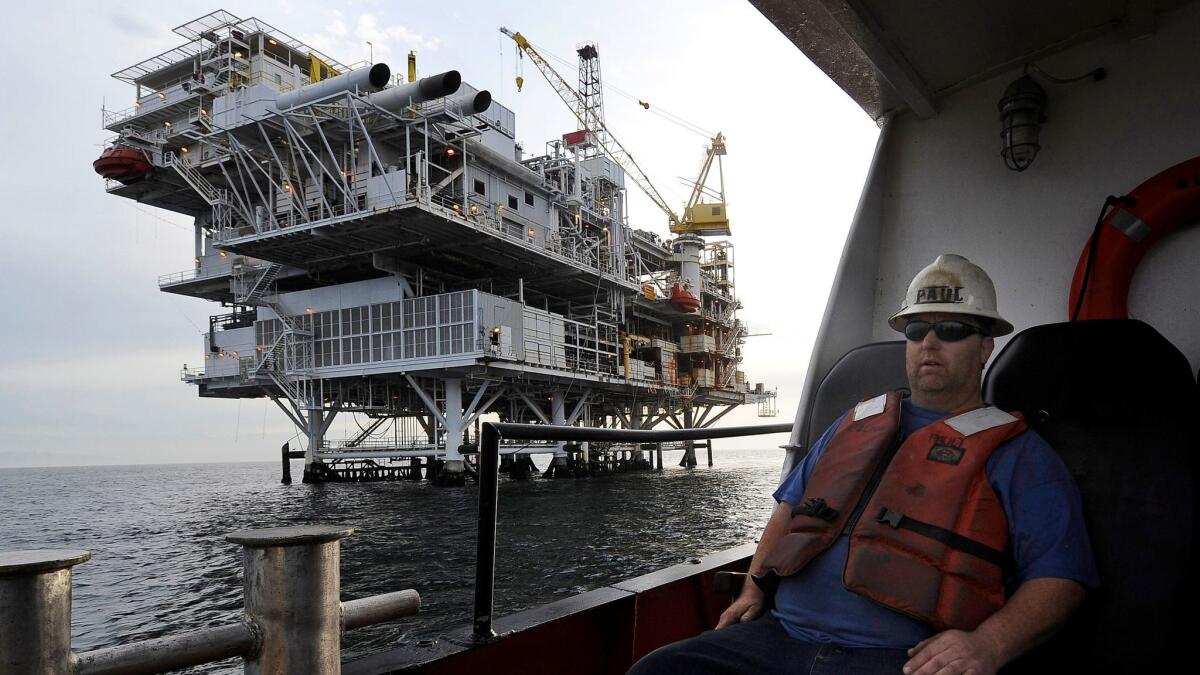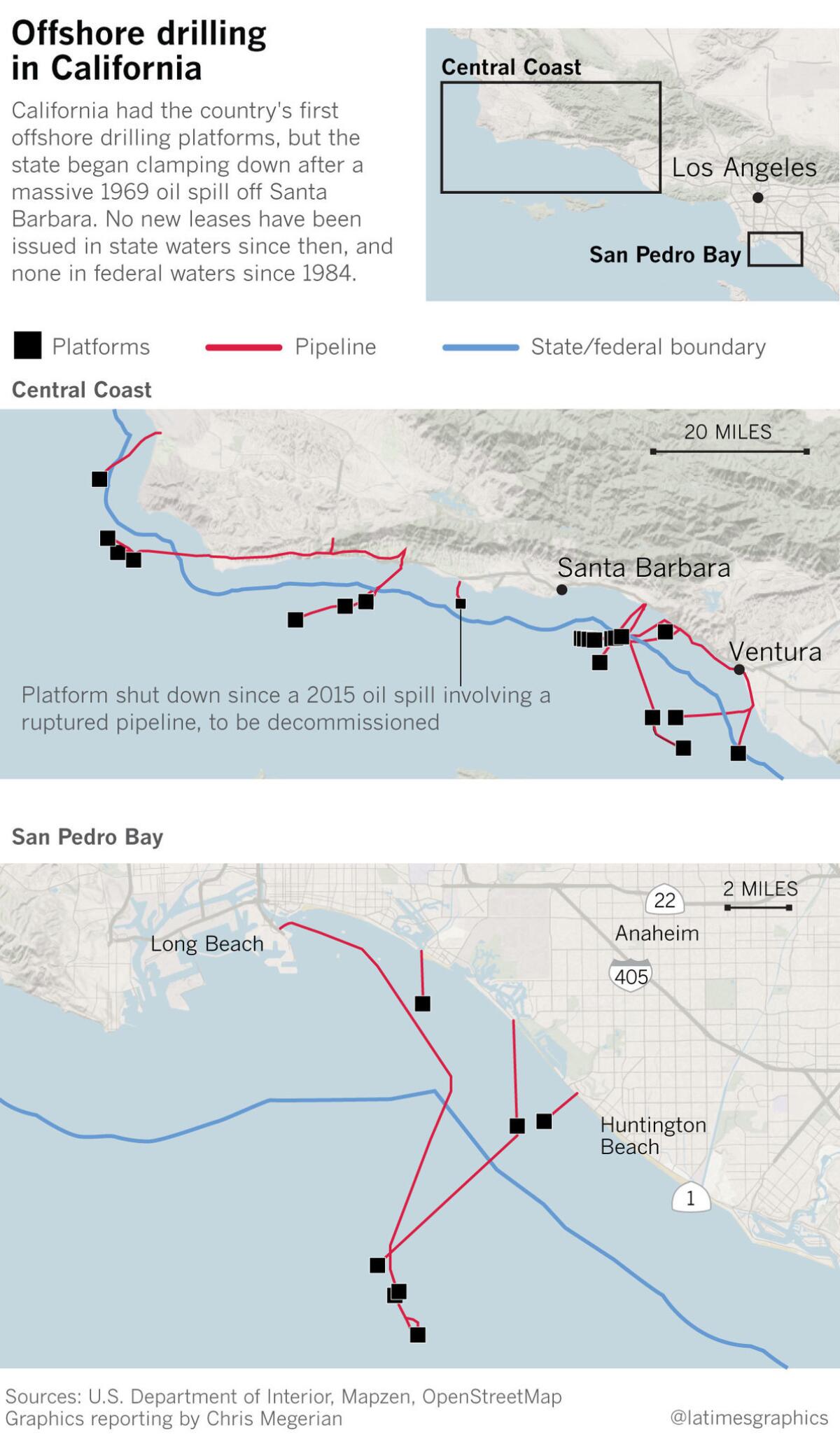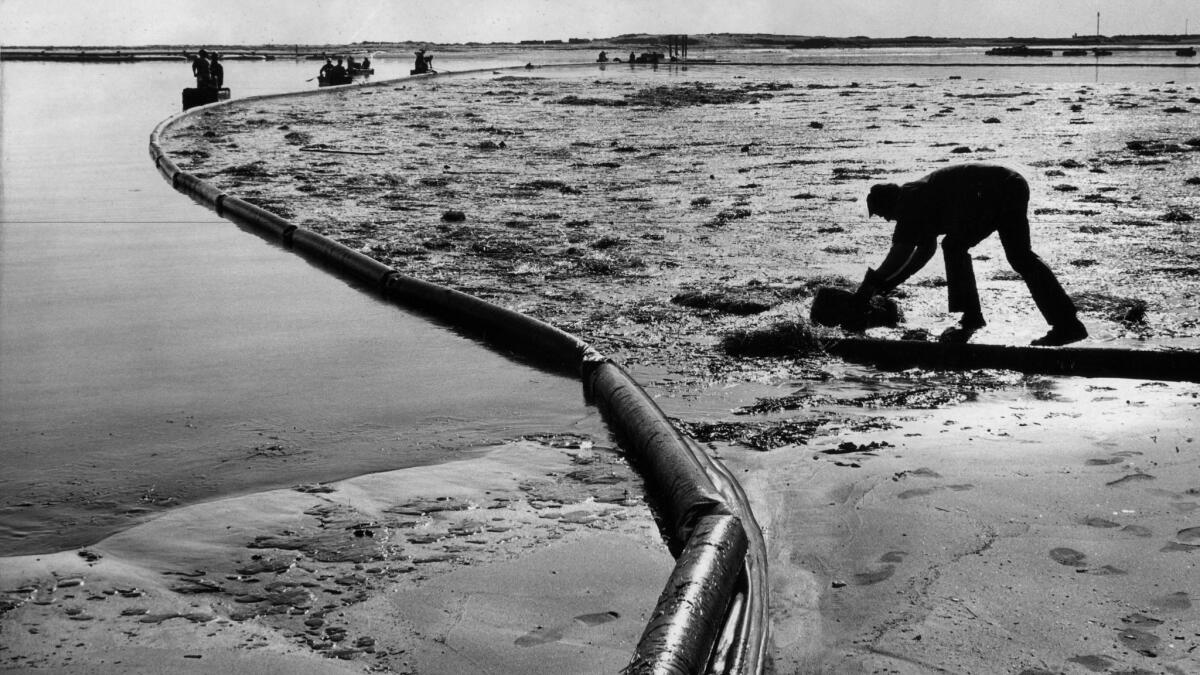Trump’s directive on offshore drilling will face solid resistance in California

- Share via
But his efforts could splash harmlessly against the hardened barricades that California has been fortifying for decades with regulation and legislation to prevent additional drilling along its treasured coast.
Even the faintest possibility of new oil operations prompted an immediate backlash in the state as environmentalists feared ecological disaster, surfers warned of soiled beaches and politicians promised new measures to block any development.
At a time when California is forging ahead with ambitious policies on climate change and renewable energy, the mere suggestion of additional derricks dotting the horizon was met with revulsion from the state’s leaders, and it brought unwelcome reminders of the coast’s painful history with oil spills.
“We will fight to the end,” said Susan Jordan, executive director of the California Coastal Protection Network, an environmental group. “They will not get any new oil on these shores."
Although the oil industry praised Trump’s executive order, there appeared to be little enthusiasm for new drilling along California’s coast. With the price per barrel below $50, expensive offshore operations may not be cost-effective, especially in a region with steep regulatory hurdles.
Most notably, even if the Trump administration awarded a new lease for drilling in federal waters, getting the oil ashore would be nearly impossible without a pipeline. State leaders pledged to stand in the way, and attempts at new developments could face endless litigation.
“I’m not worried about seeing oil derricks out there any time soon,” said Deborah A. Sivas, director of Stanford University's Environmental Law Clinic. “There are a lot of roadblocks.”

There are 27 oil platforms off California’s coast, but no new leases have been granted in federal waters since 1984. Most of the state’s oil production occurs on land. Polls show offshore drilling remains unpopular, and oil companies already mired in battles over California’s policies on climate change may be unwilling to ruffle more feathers by trying to expand drilling.
Trump’s order did not specifically mention California or the Pacific Ocean as potential areas for oil development, but left the door open to the possibility. Environmentalists were particularly alarmed by Trump’s call for a review of marine sanctuaries, which were expanded by former President Obama.
“That’s a clear statement that they’re interested in California drilling even if the other language was equivocal,” said Richard Charter, a senior fellow with the nonprofit Ocean Foundation who has been following coastal drilling issues for decades.
U.S. Interior Secretary Ryan Zinke acknowledged looming resistance to offshore drilling in California, telling reporters Thursday evening that federal officials would incorporate local input before making any decisions.
“I was out in Santa Barbara recently,” he said. “There’s a lot of people who don’t like it out there.”
That was an understatement.
“Californians will not stand for this,” said Jennifer Savage, a spokeswoman for the Surfrider Foundation, a nonprofit conservation group. “We love our coast. It's our playground, the driving force of our economy, the place where we find solace, joy and sustenance.”
Follow live coverage from the Capitol on Essential Politics »
California Atty. Gen. Xavier Becerra, along with Gov. Jerry Brown and top lawmakers, promised to fight any oil drilling.
“Instead of taking us backward, the federal government should work with us to advance the clean energy economy that’s creating jobs, providing energy and preserving California’s natural beauty,” he said.
State Sen.
“President Trump and his oil industry cronies may want to drill, but we’re going to stop that oil and gas development from being feasible,” she said.
The legislation, scheduled to be introduced next week, would buttress opposition to offshore drilling from the California Coastal Commission and the State Lands Commission, who have jurisdiction over the coastline and the waters stretching three miles into the ocean.
"California’s door is closed to President Trump’s Pacific oil and gas drilling,” said Lt. Gov. Gavin Newsom, who is chairman of the state’s lands commission.

The state was the site of the first offshore drilling in the U.S., starting with the Summerland oil field off the coast of Santa Barbara in 1896. But the same region was tarnished by the worst spill in California history in 1969, when more than 3 million gallons of oil poured into the ocean. Only the Deepwater Horizon and Exxon Valdez spills — in 2010 and 1989, respectively — have been more devastating.
The oil fouled the channel and coastline of Santa Barbara Channel from Goleta to Ventura as well as the shorelines of four channel islands. An estimated 3,700 sea birds were killed, along with a variety of marine animals, including dolphins, elephant seals and sea lions. Virtually all commercial fishing in the Santa Barbara area was halted, and tourism dropped dramatically.
Public outrage generated by the spill and widespread media coverage helped spark the modern environmental movement and prompted state and federal legislation to protect the environment.
A much smaller Santa Barbara spill in 2015, when a ruptured pipeline dumped 123,000 gallons of oil, was a reminder of the environmental dangers.
“I like to say that nothing about what Trump dreams up surprises me now — but this move is a shocking, purely political giveaway to the oil industry,” said former Rep. Mel Levine, a Democrat who represented Santa Monica in Congress from 1983 to 1993.
“There was no issue that unified my district more — regardless of what political party someone belonged to — than the anti-oil drilling battle,” Levine said.
Times staff writers Evan Halper and Louis Sahagun contributed to this report.
ALSO:
Trump order could open California coast, Arctic to new oil and gas drilling
Trump stumbled on healthcare and immigration, but on the environment he's been 'a wrecking ball'
Get the L.A. Times Politics newsletter
Deeply reported insights into legislation, politics and policy from Sacramento, Washington and beyond. In your inbox three times per week.
You may occasionally receive promotional content from the Los Angeles Times.










